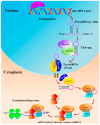Functions of Differentially Regulated miRNAs in Breast Cancer Progression: Potential Markers for Early Detection and Candidates for Therapy
- PMID: 38540304
- PMCID: PMC10968589
- DOI: 10.3390/biomedicines12030691
Functions of Differentially Regulated miRNAs in Breast Cancer Progression: Potential Markers for Early Detection and Candidates for Therapy
Abstract
Breast cancer remains a major global health concern, emphasizing the need for reliable biomarkers to enhance early detection and therapeutic interventions. MicroRNAs (miRNAs) are evolutionarily conserved small non-coding RNA (~22 nt in length) molecules, which are aberrantly expressed in cancer and seem to influence tumor behavior and progression. Specific miRNA dysregulation has been associated with breast cancer initiation, proliferation, invasion, and metastasis. Understanding the functional roles of these miRNAs provides valuable insights into the intricate molecular mechanisms underlying breast cancer progression. The diagnostic potential of miRNAs as non-invasive biomarkers for early breast cancer detection is a burgeoning area of research. This review aims to elucidate the functions of differentially regulated miRNAs in breast cancer progression and assess their potential as markers for early detection, stage-specific biomarkers, and therapeutic targets. Furthermore, the ability of specific miRNAs to serve as prognostic indicators and predictors of treatment response highlights their potential clinical utility in guiding personalized therapeutic interventions.
Keywords: biomarkers; breast cancer; microRNA.
Conflict of interest statement
The authors declare no conflict of interest.
Figures



Similar articles
-
MicroRNAs as promising biomarkers and potential therapeutic agents in breast cancer management: a comprehensive review.Ann Med Surg (Lond). 2024 Apr 22;86(6):3543-3550. doi: 10.1097/MS9.0000000000002075. eCollection 2024 Jun. Ann Med Surg (Lond). 2024. PMID: 38846828 Free PMC article. Review.
-
miRNA and cancer; computational and experimental approaches.Curr Pharm Biotechnol. 2014;15(5):429. doi: 10.2174/138920101505140828161335. Curr Pharm Biotechnol. 2014. PMID: 25189575
-
Circulating micro-RNAs as potential blood-based markers for early stage breast cancer detection.PLoS One. 2012;7(1):e29770. doi: 10.1371/journal.pone.0029770. Epub 2012 Jan 5. PLoS One. 2012. PMID: 22242178 Free PMC article.
-
A pilot study of circulating miRNAs as potential biomarkers of early stage breast cancer.PLoS One. 2010 Oct 29;5(10):e13735. doi: 10.1371/journal.pone.0013735. PLoS One. 2010. PMID: 21060830 Free PMC article.
-
Circulating microRNAs as Potential Biomarkers in Pancreatic Cancer-Advances and Challenges.Int J Mol Sci. 2023 Aug 28;24(17):13340. doi: 10.3390/ijms241713340. Int J Mol Sci. 2023. PMID: 37686149 Free PMC article. Review.
Cited by
-
MicroRNA-155 as Biomarker and Its Diagnostic Value in Breast Cancer: A Systematic Review.World J Oncol. 2025 Feb;16(1):1-15. doi: 10.14740/wjon1955. Epub 2024 Dec 31. World J Oncol. 2025. PMID: 39850528 Free PMC article. Review.
-
Tumor Suppressor miRNA-based Signatures in Triple Negative Breast Cancer: A Study Based on Big Data Analysis of Gene Expression Omnibus (GEO) Datasets and Its Validation.Asian Pac J Cancer Prev. 2025 Jun 1;26(6):2087-2095. doi: 10.31557/APJCP.2025.26.6.2087. Asian Pac J Cancer Prev. 2025. PMID: 40542771 Free PMC article.
-
microRNAs as Biomarkers of Breast Cancer.Int J Mol Sci. 2025 May 6;26(9):4395. doi: 10.3390/ijms26094395. Int J Mol Sci. 2025. PMID: 40362631 Free PMC article. Review.
References
-
- Lakhani S.R., Ellis I.O., Schnitt S., Tan P.H., van de Vijver M., editors. WHO Classification of Tumours of the Breast. IARC; Lyon, France: 2012.
-
- Ferlay J., Ervik M., Lam F., Laversanne M., Colombet M., Mery L., Piñeros M., Znaor A., Soerjomataram I., Bray F. Global Cancer Observatory: Cancer Today. International Agency for Research on Cancer; Lyon, France: 2024. [(accessed on 12 December 2023)]. Available online: https://gco.iarc.who.int/today.
Publication types
LinkOut - more resources
Full Text Sources
Research Materials

